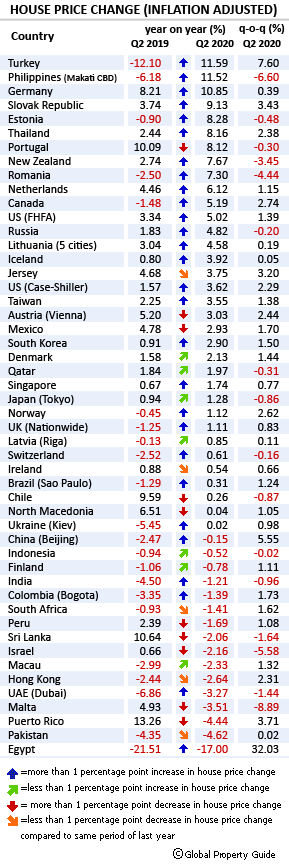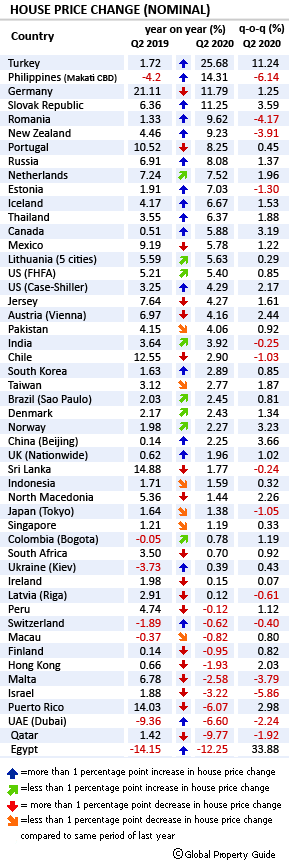MATTHEW MONTAGU-POLLOCK | September 04, 2020
During the year to Q2 2020:
- Surprisingly, global housing markets remained extraordinarily vibrant during the year to Q2 2020, especially in Europe, Canada and the US. Real house prices (i.e., prices adjusted for inflation) rose in 33 out of the 49 world’s housing markets which have so far published housing statistics.
- The more upbeat nominal figures, more familiar to the public, showed house price rises in 38 countries, and declines in only 11 countries.
- This is happening despite transaction volumes suffering an enormous hit from lockdowns and travel restrictions associated with the COVID-19 outbreak.
- The most likely explanation is lower interest rates. Many central banks compensated for weak economies through lower interest rates and Quantitative Easing.
- Strong house price surges have taken place in European countries, such as Turkey, Germany, Slovak Republic, Estonia, as well as Portugal.
- Despite being the new epicentre of the coronavirus outbreak, the U.S. housing market remains surprisingly robust. The S&P/Case-Shiller seasonally-adjusted national home price index rose by 3.62% during the year to Q2 2020 (inflation-adjusted), an improvement from the previous year’s 1.57% growth. The Federal Housing Finance Agency displayed an even more rosy picture (from the seller’s perspective) with its seasonally-adjusted purchase-only U.S. house price index rising by 5.02% y-o-y in Q2 2020 (inflation-adjusted), up from the previous year’s 3.34% growth and the biggest increase since Q4 2015.
- Thirty-four of the 49 surveyed housing markets showed stronger momentum in Q2 2020 compared to the previous year.
Recently, the International Monetary Fund (IMF) revised its 2020 forecast for the global economy to a contraction of 4.9%, down from its earlier projection of a 3% decline. The agency predicts that all regions of the world will experience negative growth this year. Despite the significant economic slowdown, recent trends suggest continued rises in housing markets, with the boost to asset values from quantitative easing outweighing the negative economic impact of the crisis.
The strongest housing markets in our global house price survey during the year to Q2 2020 included: Turkey (+11.59%), Makati CBD, Philippines (+11.52%), Germany (+10.85%), Slovak Republic (+9.13%), and Estonia (+8.28%), using inflation-adjusted figures.
The biggest y-o-y house-price declines were in Egypt (-17%), Pakistan (-4.62%), Puerto Rico (-4.44%), Malta (-3.51%), and Dubai, UAE (-3.27%), again using inflation-adjusted figures.
Momentum is stronger: 34 of the world’s housing markets for which figures are available showed stronger upward momentum during Q2 2020, while only 15 housing markets showed weaker momentum, according to Global Property Guide’s research. In fact the U.S., the current epicentre of the coronavirus pandemic, has surprisingly showed stronger momentum in Q2 2020 from a year ago. Momentum is a measure of the “change in the change”; simply put, momentum has increased if a property market has risen faster this year than last (or fallen less).
Inflation-adjusted figures are used throughout this survey. In the case of Kiev, Ukraine, the Global Property Guide adjusts using the official U.S. inflation rate since Ukrainian secondary market dwelling sales are denominated in U.S. dollars.
 |
| Source: Various series, data descriptions and sources here |
The strongest performing markets:
Portugal has emerged as the strongest housing market in our global house price survey, with house prices surging by 11.59% during the year to Q2 2020, a sharp turnaround from the previous year’s 12.1% y-o-y fall, using inflation-adjusted figures. It was the second consecutive quarter of y-o-y growth in real prices since Q1 2017. On a quarterly basis, real house prices increased 7.6% in Q2 2020.
All figures that follow are inflation-adjusted.
The Philippines’ housing market made a strong comeback, after slowing sharply last year. The average price of 3-bedroom condominium units in Makati CBD surged by 11.52% during the year to Q2 2020, in stark contrast to the prior year’s 6.18% y-o-y fall. Though quarter-on-quarter, house prices in the CBD fell by 6.6% in Q2 2020.
Germany’s housing market continues to experience strong demand, buoyed by extremely low interest rates. The average price of apartments rose by a huge 10.85% during the year to Q2 2020, an improvement from the prior year’s 8.21% growth. On a quarterly basis, house prices increased slightly by 0.39% in Q2 2020.
Slovak Republic’s housing market has been strengthening, with the nationwide house prices rising by 9.13% in Q2 2020 from a year earlier, a sharp improvement from the previous year’s 3.74% growth and its biggest y-o-y increase since Q3 2008. On a quarterly basis, real house prices increased 3.43% during the latest quarter.
Estonia’s housing market remains robust, with the residential property prices rising by 8.28% during the year to Q2 2020, a sharp turnaround from a y-o-y decline of 0.96% in Q2 2019 and its biggest increase in two years. Though quarter-on-quarter, house prices fell slightly by 0.48% in Q2 2020.
 |
| Source: Various series, data descriptions and sources here |
THE WORLD’S REGIONS:
Europe’s great house price boom continues
Europe’s house price boom continues unabated. Four of the five strongest housing markets in our global survey are in Europe. House prices have risen in no less than 20 of the 22 European housing markets for which figures were available during the year to Q2 2020.
Turkey’s housing market is recovering remarkably, buoyed by strong demand from both local and foreign investors. The nationwide house price index surged by 11.59% during the year to Q2 2020, a sharp turnaround from the previous year’s 12.1% y-o-y fall. It was the second consecutive quarter of y-o-y growth in real prices since Q1 2017. On a quarterly basis, real house prices rose 7.6% in Q2 2020.
For foreigners, Turkey’s currency devaluation means that the property market is very attractively priced, luring many buyers from the Gulf. In the first seven months of 2020, home sales rose strongly by 40.5% y-o-y to 854,126 units, according to Turkish Statistical Institute (TurkStat). Yet the economy is projected to contract by 5%, according to the IMF, due to the lockdowns and travel restrictions imposed since reporting its first COVID-19 case in March 10, 2020. It would be the Turkish economy’s first contraction since 2009.
Germany’s house price growth continues to accelerate, despite a coronavirus-induced economic recession. The average price of apartments rose by a huge 10.85% during the year to Q2 2020, following y-o-y rises of 12% in Q1 2020, 11.15% in Q4 2019, 9.46% in Q3, and 8.21% in Q2. On a quarterly basis, house prices increased slightly by 0.39% in Q2 2020.
Germany has long been a picture of housing market stability and one of the few countries that avoided a house-price slump in the wake of the 2008-2009 global financial crisis. However, the German economy plunged deep into recession in Q2 2020, with real GDP shrinking by a whopping 10.1% from the previous quarter, following q-o-q declines of 2% in Q1 2020 and 0.1% in Q4 2019. It was the biggest quarterly drop since Germany started to publish quarterly GDP calculations in 1970. The economy is projected to shrink by 6.3% this year, following minuscule growth of 0.6% in 2019, based on figures from the European Commission.
Other strong European housing markets include Slovak Republic, with house prices rising by 9.13% during the year to Q2 2020, Estonia (8.28%), Portugal (8.12%), Romania (7.3%), and The Netherlands (6.12%). All, except Portugal, had stronger performances in Q2 2020 compared to the previous year. Yet only Slovak Republic and The Netherlands recorded positive quarterly growth during the latest quarter.
There have been modest annual house price rises in Russia (4.82%), Lithuania (4.58%), Iceland (3.92%), Jersey (3.75%), Vienna, Austria(3.03%), and Denmark (2.13%). All except Russia saw quarterly price growth during the latest quarter. Moreover, all except Jersey and Austria, performed better in Q2 2020 compared to a year earlier.
European housing markets that are almost steady include Norway, with house prices rising by a minimal 1.12% during the year to Q2 2020, UK (1.11%), Riga, Latvia (0.85%), Switzerland (0.61%), Ireland (0.54%), North Macedonia (0.04%), and Kiev, Ukraine (0.02%). All, except Switzerland, recorded quarterly price growth during the latest quarter. In addition, all except Ireland and North Macedonia had stronger performances during Q2 2020 as compared to a year earlier.
In fact The UK’s housing market continues to show signs of improvement. Real house prices rose by 1.11% during the year to Q2 2020, in contrast to the previous year’s 1.25% decline and its best performance since Q1 2017. Quarter-on-quarter, real house prices increased slightly by 0.83% during the latest quarter. The North West was the best performing region during the year to Q2 2020, with real house prices rising by 3.9%, followed by Scotland (3.1%) and South West (1.4%). London real house prices increased 1.2%.
The UK’s real GDP shrank by a whopping 20.4% quarter-on-quarter in Q2 2020, the biggest drop since records began in 1955. It was the second consecutive q-o-q fall, officially putting the country into technical recession. Despite this, the Bank of England (BoE) has recently revised its full-year 2020 forecast to a 9.5% contraction, up from its previous 14% projection.
Europe’s weakest housing markets
Only two of the 22 European housing markets for which figures were available during the year to Q2 2020 showed falling house prices: Malta and Finland.
After more than three years of double-digit house price rises, Malta’s housing market started to cool in the second half of 2019. Nationwide house prices fell by 3.51% during the year to Q2 2020, its worst showing since Q4 2012. It was the second consecutive quarter of y-o-y decline, following a slight 0.17% fall in Q1. On a quarterly basis, house prices actually fell by a huge 8.89% in Q2 2020. The European Commission expects Malta’s economy to contract by 6% this year, in contrast to a 4.7% growth in 2019.
Finland’s housing market remains weak, amidst falling demand. The average price of dwellings fell 0.78% during the year to Q2 2020, following y-o-y declines of 1.33% in Q1 2020, 2.69% in Q4 2019, 0.89% in Q3 2019, and 1.06% in Q2 2019. Quarter-on-quarter, house prices rose by 1.11% in Q2 2020. In the first half of 2020, total transactions of old dwellings fell by 17.6% y-o-y to 25,438 units, following a 1.4% increase in 2019, according to Statistics Finland. The economy is projected to contract by 6.3% this year, in contrast to 1.1% growth in 2019, based on the European Commission estimates.
The Asia-Pacific region is improving
Eleven of the fourteen Asia-Pacific housing markets included in our global survey showed stronger momentum in Q2 2020 compared to a year earlier. House prices rose in seven countries, with notable increases in the Philippines, Thailand and New Zealand.
After slowing sharply last year, The Philippines’ housing market made a strong comeback, with the average price of 3-bedroom condominium units in Makati CBD surging by 11.52% during the year to Q2 2020, a sharp turnaround from the previous year’s 6.18% y-o-y fall. However quarter-on-quarter, house prices in the CBD fell by 6.6% in Q2 2020.
The Philippines experienced a house price boom from 2010 to 2018, with Makati CBD prices rising by more than 132% (76% inflation-adjusted). But with a slowing domestic economy, coupled with the US-China trade war, the housing market slowed sharply last year. Surprisingly despite the COVID-19 pandemic, the housing market has bounced back quickly this year, mainly due to the Philippines’ attractiveness to investors due to high rental yields, and the release of the much-awaited Implementing Rules and Regulations (IRR) of the Real Estate Investment Trust Act of 2009 early this year.
The Philippine economy fell into a coronavirus-induced recession this year, with real GDP falling by 16.5% q-o-q in Q2 2020. As such, the government recently revised down its 2020 economic forecast to a contraction of 5.5%, worse than its earlier projection of a contraction of between 2% and 3.4%.
Thailand’s housing market continues to strengthen, despite deteriorating economic conditions. Nationwide house prices rose by 8.16% during the year to Q2 2020, a sharp improvement from the previous year’s 2.44% increase and the strongest growth since Q3 2013. House prices increased 2.38% q-o-q during the latest quarter.
Thailand’s economy shrank by a whopping 12.2% in Q2 2020 from a year earlier, following a 2% decline in Q1, as the COVID-19 pandemic hit domestic activity and tourism. It was the biggest contraction since the 1998 Asian Financial Crisis. As such, the National Economic and Social Development Council (NESDC) recently slashed its 2020 economic forecast to a contraction of 7.3% to 7.8%, from an earlier estimate of a 5% to 6% decline.
New Zealand’s house prices have continued to rise strongly, as the impact of the ban on non-resident foreign homebuyers has waned. Median house prices rose by 7.67% during the year to Q2 2020, up from the previous year’s 2.74% growth. Though on a quarterly basis, real house prices fell by 3.45% in Q2 2020.
Despite the COVID-19 pandemic and the subsequent lockdowns, property sales in New Zealand soared 24.6% y-o-y to 7,854 units in July 2020, the highest level recorded in a month of July for 5 years, according to the Real Estate Institute of New Zealand (REINZ). In contrast, the number of properties available for sale fell by 11% to 19,441 units in July 2020 from a year earlier – the lowest level of inventory for the month of July since records began.
For the last six years New Zealand’s economy’s performance has been robust, with growth of 2.2% in 2019, 3.2% in 2018, 3.8% in 2017, 4.2% in 2016, 4.1% in 2015 and 3.2% in 2014. However, the economy is now projected to plunge as much as 7.2% this year, as the effect of lockdowns and travel restrictions associated with the COVID-19 pandemic hits, based on IMF projections.
There were modest to minimal house price rises in Taiwan (3.55%), South Korea (2.9%), Singapore (1.74%), and Tokyo, Japan (1.28%). All performed more strongly in Q2 2020 than a year earlier. Also, all except Japan saw house price rises during the latest quarter.
Some Asia-Pacific housing markets continue to struggle
Pakistan’s high inflation makes it appear that house prices are still rising. But this is an illusion. Nationwide house prices actually declined 4.62% during the year to Q2 2020 when adjusted for inflation, though in nominal terms they rose by 4.06%. Quarter-on-quarter, house prices were almost unchanged in inflation-adjusted terms. After registering an eight-year high of 14.6% in January 2020, Pakistan’s inflation slowed to 8.59% in June 2020.
Pakistan’s economy contracted by 0.7% during the fiscal year 2019-20, compared to a 1.91% growth in 2018-19, mainly due to economic stabilization policies that hit the industrial sector, coupled with the adverse effects of the COVID-19 outbreak, according to the National Accounts Committee. The International Institute of Finance (IIF) projects the economy to grow by 1.8% in FY2020-21 amidst signs of recovery in private consumption.
Hong Kong’s housing market suffered several blows recently – from market-cooling measures, the impact of the violent protests, the US-China trade war, and now the COVID-19 outbreak. Hong Kong’s residential property prices fell by 2.64% during the year to Q2 2020, at par with the previous year’s 2.44% fall. Yet on a quarterly basis, house prices rose 2.31% in Q2 2020.
Months of violent protests and the US-China trade war forced HK’s economy into its first recession in a decade last year, contracting by 1.2% last year. Now the coronavirus outbreak threatens to make things worse, after the economy declined by 9.1% y-o-y in Q1 2020 and by another 9% in Q2 – its two worst contractions since records began in 1974. Recently, the HK government downgraded its full-year forecast to a contraction of 6% to 8%, from its earlier estimate of a decline between 4% and 7%.
Other weak Asia-Pacific housing markets included Macau, with house prices falling by 2.33% during the year to Q2 2020, Sri Lanka (-2.06%), India (-1.21%), Indonesia (-0.52%), and Beijing, China (-0.15%). Yet only Sri Lanka showed weaker performance in Q2 2020 as compared to a year earlier. Only China and Macau saw quarterly rises in Q2 2020.
The Middle East remains dismal
The Middle East’s housing markets have been struggling for several years now, due to plummeting oil prices and the ongoing political and diplomatic crisis. Now, the coronavirus pandemic has aggravated the situation. Recently, the International Monetary Fund (IMF) downgraded its 2020 economic forecast for MENA region to -5.7%, down from its April’s projection of -3.3%.
Egypt’s housing market remains the weakest housing market in our global survey, with the nationwide real estate index plunging by 17% during the year to Q2 2020, following y-o-y declines of 34.14% in Q1 2020, 2.28% in Q4 2019, 9.58% in Q3 2019, 21.51% in Q2 2019 and 22.61% in Q1 2019. Part of the explanation is undoubtedly the very high interest rates available on deposits in Egyptian Pounds. However real house prices actually increased 32.03% q-o-q during the latest quarter (though tthe violent swings may indicate unreliable statistics).
President Abdel Fattah el-Sisi recently removed the last restrictions on foreign ownership of land and property in Egypt, in an effort to buoy the housing market. He also allowed the government, the biggest landowner in Egypt, to use its land for public-private partnership schemes. However house prices are being undermined by the vast amount of new construction, for instance in the new capital. On a positive note, Egypt is one of the only two countries in the MENA region whose economy the IMF expects to grow in 2020, at a rate of 2%.
The UAE’s housing market continues to suffer, amidst a huge supply glut of both apartments and oil. In Dubai, residential property prices fell by 3.27% during the year to Q2 2020, an improvement from the previous year’s 6.86% decline. During the latest quarter, house prices in Dubai fell by 1.44% q-o-q. The UAE’s overall economy is forecast to contract by 3.5% this year, following 2.9% growth in 2019, mainly due to the crude oil price crash caused by the COVID-19 outbreak, according to the IMF.
Israel’s housing market remains weak with the nationwide average price of owner-occupied dwellings falling by 2.16% during the year to Q2 2020, in contrast to a y-o-y growth of 0.66% the previous year. Israeli house prices fell 5.58% q-o-q in Q2 2020. Recently, the Bank of Israel revised its 2020 economic forecast for the country to -6%, a downgrade from its May estimate of -4.5%.
Qatar’s housing market remains weak, despite the government’s continuous effort to mitigate the economic and financial fallout of the ongoing blockade, as well as the coronavirus outbreak. The nationwide real estate price index rose by 1.97% during the year to Q2 2020, following y-o-y changes of -3.6% in Q1 2020, 0.55% in Q4 2019, and -6.86% in Q3 2019. Property prices fell by 0.31% q-o-q during the latest quarter. The Qatari economy is projected to decline by 4.3% this year, following almost zero growth in 2019, according to the IMF.
The Americas: US and Canada strengthen
U.S. house prices have continued to rise robustly and Canada’s housing market is strengthening again, but the outlook for both countries remains unclear due to uncertainties surrounding the COVID-19 outbreak.
After seven years of strong house price growth, the U.S. housing market remains surprisingly vibrant. The S&P/Case-Shiller seasonally-adjusted national home price index rose by 3.62% during the year to Q2 2020 (inflation-adjusted), an improvement from the previous year’s 1.57% growth. Real house prices increased 2.29% during the latest quarter.
In fact the Federal Housing Finance Agency showed a more rosy picture with its seasonally-adjusted purchase-only U.S. house price index rising strongly by 5.02% y-o-y in Q2 2020 (inflation-adjusted), up from the prior year’s 3.34% growth and the biggest increase since Q4 2015. The FHFA index rose by 1.39% q-o-q during the latest quarter.
Both housing demand and supply are now rising again, despite the economic fallout from the coronavirus pandemic. Sales of new single-family houses surged 36.3% y-o-y to a seasonally-adjusted annual rate of 901,000 units in July 2020. Likewise, existing home sales rose by 8.7% y-o-y to a seasonally-adjusted annual rate of 5.86 million units in July 2020.
New housing starts rose sharply by 23.4% y-o-y to a seasonally-adjusted annual rate of 1,496,000 units in July 2020, while completions were up slightly by 1.7% to 1,280,000 units.
U.S. homebuilder sentiment soared to a record high of 78 in August 2020, as homebuyers sought more space in less urban areas, amidst limited supply, according to the National Association of Home Builders (NAHB)/Wells Fargo Housing Market Index (HMI). Sentiment plunged to 30 in April 2020 when the COVID-19 pandemic shut down the US economy. A reading of 50 is the midpoint between positive and negative sentiment.
The U.S. economy shrank by a whopping annual rate of 32.9% in Q2 2020, following a y-o-y fall of 5% in Q1, amidst social distancing restrictions and lockdowns. It was the steepest decline on record dating back to the 1940s. The world’s biggest economy is expected to shrink by 6.6% this year, the first contraction in 11 years, based on IMF estimates. The unemployment rate dropped to 10.2% in July 2020, after registering a record high of 14.7% in April 2020.
Canada’s housing market is growing stronger again, as the impact of market-cooling measures has waned. House prices in the country’s eleven major cities rose by 5.19% during the year to Q2 2020, in contrast to a y-o-y fall of 1.48% the previous year. Quarter-on-quarter, house prices increased 2.74% in Q2 2020.
Demand has rebounded quickly with sales surging by 30.5% to 62,355 transactions in July 2020 from a year earlier, according to the Canadian Real Estate Association (CREA) – the highest monthly sales for more than four decades. Construction activity showed mixed results with housing starts falling by 3.6% y-o-y to 105,767 units in the first half of 2020 while completions increased 1.5% to 104,115 units.
In Q2 2020, Canada’s economic output fell by a record 12%, following an annualized 8.2% fall the previous quarter, as consumer spending and business activity ground to a halt due to the COVID-19 pandemic. As such, Bank of Canada (BoC) projects the Canadian economy will shrink by 7.8% this year before bouncing back next year with 5.1% growth.
Latin America’s housing markets remain weak
Mexico’s nationwide house price index rose by a modest 2.93% during the year to Q2 2020, down from the previous year’s 4.78% growth. On a quarterly basis, house prices rose by 1.7% in Q2. The Mexican economy shrank by 0.3% in 2019, the weakest performance in a decade. The country’s economic woes are expected to be extended this year, with IMF recently revising its 2020 economic forecast to a huge 10.5% contraction, worse than its earlier estimate of a 6.6% decline.
Brazil’s housing market is now stabilizing. In Sao Paulo, house prices rose slightly by 0.31% y-o-y in Q2 2020, in contrast to an annual fall of 1.29% in Q2 2019 and the first real house price growth since Q4 2014. On a quarterly basis, house prices in Sao Paulo increased 1.24% in Q2 2020. The economy grew by a minuscule 1.1% in 2019, and is expected to contract by 5.7% this year, based on the latest central bank survey.
Chile’s housing market is slowing rapidly, as the coronavirus pandemic shatters its economy. The average price of new apartments in Greater Santiago rose by a minuscule 0.26% during the year to Q2 2020, sharply down from the previous year’s 9.59% growth. On a quarterly basis, house prices fell by 0.87% in Q2 2020. The Central Bank of Chile expects the economy to contract 5.5% to 7.5% this year, the biggest decline since the Latin American debt crisis of the 1980s.
Colombia’s housing market continues to slow, after several years of vigorous price rises. In Bogotá, house prices fell by 1.39% during the year to Q2 2020, following a decline of 3.35% y-o-y the previous year. Though during the latest quarter, house prices rose 1.73% q-o-q. The country’s central bank expects the economy to contract by up to 7% this year due to the pandemic, as well as falling oil prices.
Peru’s housing market continues to suffer, with house prices falling by 1.69% during the year to Q2 2020, in contrast to the previous year’s 2.39% increase. During the latest quarter, house prices increased 1.08% q-o-q. The economy is projected to contract by 4.5% this year, the first decline since 1998.
South Africa’s housing market is still gloomy
South Africa’s housing market remains sluggish, amidst a depressed macroeconomic environment. The price index for medium-sized apartments fell by 1.41% during the year to Q2 2020, following y-o-y declines of 2.56% in Q1 2020, 0.9% in Q4 2019, 0.33% in Q3, 0.93% in Q2, and 1.08% in Q1. On a quarterly basis, house prices increased 1.62% in Q2 2020.
Recently, the South African Reserve Bank (SARB) downgraded its economic forecast for the country to -7.3%, from its earlier estimate of -7%. The economy grew by only 0.2% last year, following expansions of 0.8% in 2018, 1.4% in 2017 and 0.4% in 2016.
Puerto Rico’s housing market remains depressed
Puerto Rico’s housing market continues to suffer, with the seasonally-adjusted purchase-only house price index falling by 4.44% during the year to Q2 2020, in contrast to an increase of 13.26% y-o-y a year earlier, using inflation-adjusted figures. Quarter-on-quarter, house prices increased 3.71% in Q2 2020.
The Puerto Rican housing market has suffered tremendously for most of the decade. The island has experienced a prolonged economic crisis, massive debt, high unemployment and continuing population loss. With US$70 billion in debt and US$50 billion in pension liabilities, Puerto Rico’s bankruptcy filing in May 2017 was the biggest in the history of the United States. The economy is projected to contract by 6% this year, amidst the COVID-19 pandemic.
https://www.globalpropertyguide.com/investment-analysis/Pandemic-paradox-Global-housing-markets-continued-to-rise-strongly-in-Q2-defying-the-pandemic




